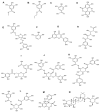Phytochemical Analysis and Antimicrobial Activity of Terminalia bellirica (Gaertn.) Roxb. and Terminalia chebula Retz. Fruit Extracts Against Gastrointestinal Pathogens: Enhancing Antibiotic Efficacy
- PMID: 39770866
- PMCID: PMC11728670
- DOI: 10.3390/microorganisms12122664
Phytochemical Analysis and Antimicrobial Activity of Terminalia bellirica (Gaertn.) Roxb. and Terminalia chebula Retz. Fruit Extracts Against Gastrointestinal Pathogens: Enhancing Antibiotic Efficacy
Abstract
Terminalia bellirica (Gaertn) Roxb. and Terminalia chebula Retz. are significant botanicals in ancient Ayurvedic medicine. They are renowned for their therapeutic properties, notably in addressing gastrointestinal (GI) diseases. These plants have undergone thorough examination related to their antibacterial, anti-inflammatory, and antioxidant properties, which make them highly efficient natural treatments for controlling gastrointestinal infections. The current research demonstrated the antibacterial efficacy of fruit extracts of Terminalia bellirica and Terminalia chebula against Bacillus cereus, Shigella sonnei, Shigella flexneri, and Salmonella typhimurium. We performed disc diffusion and liquid microdilution experiments to evaluate the antibacterial efficacy. All extracts of Terminalia bellirica and Terminalia chebula showed good antibacterial effects against B. cereus and S. flexneri. The minimum inhibitory concentration (MIC) values ranged from 94 µg/mL to 556 µg/mL. The methanolic extracts from both plants also showed noteworthy antibacterial activity against S. sonnei and S. typhimurium, with MIC values of 755 µg/mL for both. Fractional inhibitory concentration studies revealed additive interactions between some conventional antibiotics and the plant extracts when used concurrently. Liquid chromatography-mass spectrometry (LC-MS) analyses revealed that the T. bellirica and T. chebula extracts contained various tannins including methyl gallate, propyl gallate, gallic acid, and ellagic acid. Lethality assays conducted using Artemia franciscana Kellogg nauplii indicated that all the plant extracts are non-toxic. The antibacterial properties and absence of toxicity in T. bellirica and T. chebula fruit extracts indicate their potential for antibiotic development, warranting additional mechanistic and phytochemical studies.
Keywords: LC-MS; combinational therapies; gallotannins; gastrointestinal pathogens; herbal antidiarrheals; medicinal plants; plant-derived antimicrobials.
Conflict of interest statement
The authors declare no conflicts of interest.
Figures


Similar articles
-
Combinations of Terminalia bellirica (Gaertn.) Roxb. and Terminalia chebula Retz. Extracts with Selected Antibiotics Against Antibiotic-Resistant Bacteria: Bioactivity and Phytochemistry.Antibiotics (Basel). 2024 Oct 19;13(10):994. doi: 10.3390/antibiotics13100994. Antibiotics (Basel). 2024. PMID: 39452260 Free PMC article.
-
Cold maceration extraction of wild fruit Terminalia bellirica (Gaertn.) Roxb.: exploring its bioactives for biomedical applications.Prep Biochem Biotechnol. 2024 Aug;54(7):982-1000. doi: 10.1080/10826068.2024.2313632. Epub 2024 Feb 13. Prep Biochem Biotechnol. 2024. PMID: 38349742
-
Anti Helicobacter pylori activity and gastrointestinal protective effects of Terminalia bellirica: Mechanistic insights from in vitro and in vivo studies.J Ethnopharmacol. 2025 Apr 9;345:119569. doi: 10.1016/j.jep.2025.119569. Epub 2025 Mar 5. J Ethnopharmacol. 2025. PMID: 40054639
-
Terminalia bellirica (Gaertn.) roxb. (Bahera) in health and disease: A systematic and comprehensive review.Phytomedicine. 2020 Oct;77:153278. doi: 10.1016/j.phymed.2020.153278. Epub 2020 Jul 5. Phytomedicine. 2020. PMID: 32781393
-
Exploring scientific validation of Triphala Rasayana in ayurveda as a source of rejuvenation for contemporary healthcare: An update.J Ethnopharmacol. 2021 Jun 12;273:113829. doi: 10.1016/j.jep.2021.113829. Epub 2021 Jan 17. J Ethnopharmacol. 2021. PMID: 33465446 Review.
Cited by
-
Antibacterial and Synergistic Effects of Terminalia citrina Leaf Extracts Against Gastrointestinal Pathogens: Insights from Metabolomic Analysis.Antibiotics (Basel). 2025 Jun 8;14(6):593. doi: 10.3390/antibiotics14060593. Antibiotics (Basel). 2025. PMID: 40558183 Free PMC article.
References
-
- World Health Organization Diarrhoeal Disease. 2024. [(accessed on 31 July 2024)]. Available online: https://www.who.int/news-room/fact-sheets/detail/diarrhoeal-disease.
-
- Troeger C., Blacker B.F., Khalil I.A., Rao P.C., Cao S., Zimsen S.R., Albertson S.B., Stanaway J.D., Deshpande A., Abebe Z., et al. Estimates of the global, regional, and national morbidity, mortality, and aetiologies of diarrhoea in 195 countries: A systematic analysis for the Global Burden of Disease Study 2016. Lancet Infect. Dis. 2018;18:1211–1228. doi: 10.1016/S1473-3099(18)30362-1. - DOI - PMC - PubMed
-
- El-Arabi T.F., Griffiths M.W. Foodborne Infections and Intoxications. Elsevier Science; Amsterdam, The Netherlands: 2021. Bacillus cereus; pp. 431–437. - DOI
LinkOut - more resources
Full Text Sources
Molecular Biology Databases

